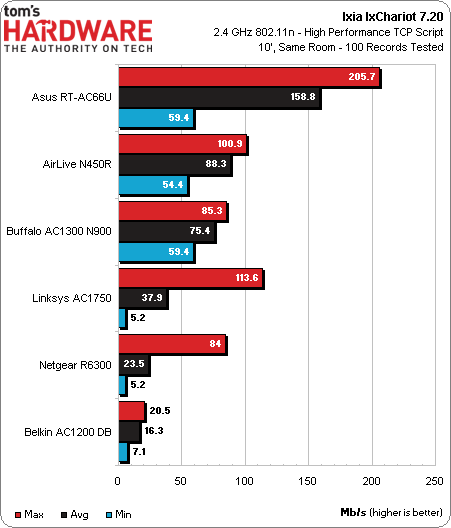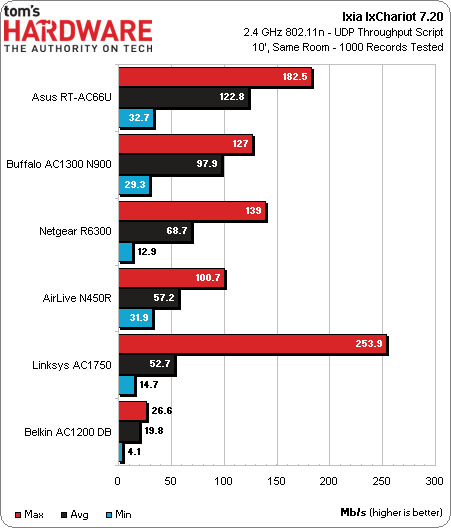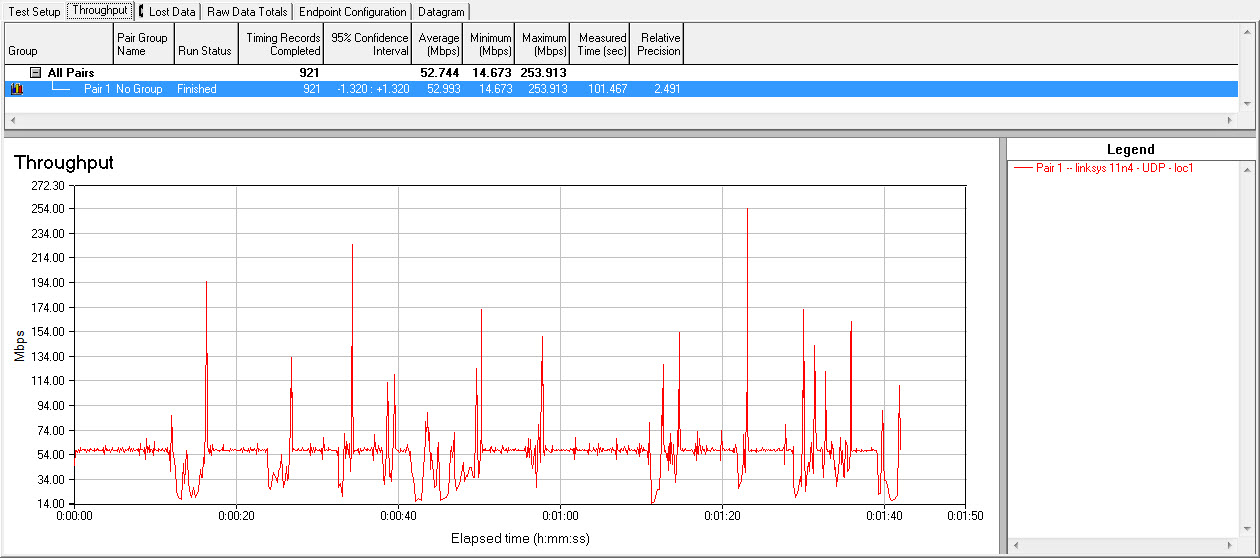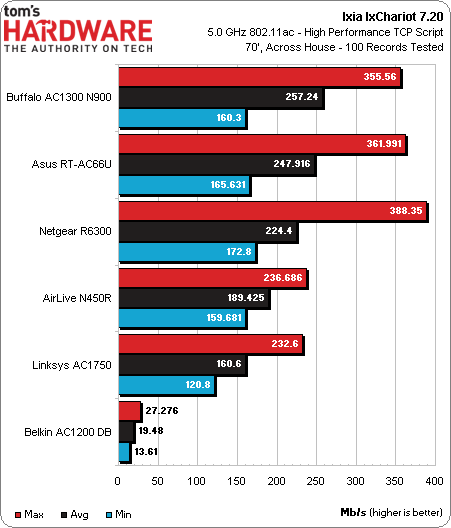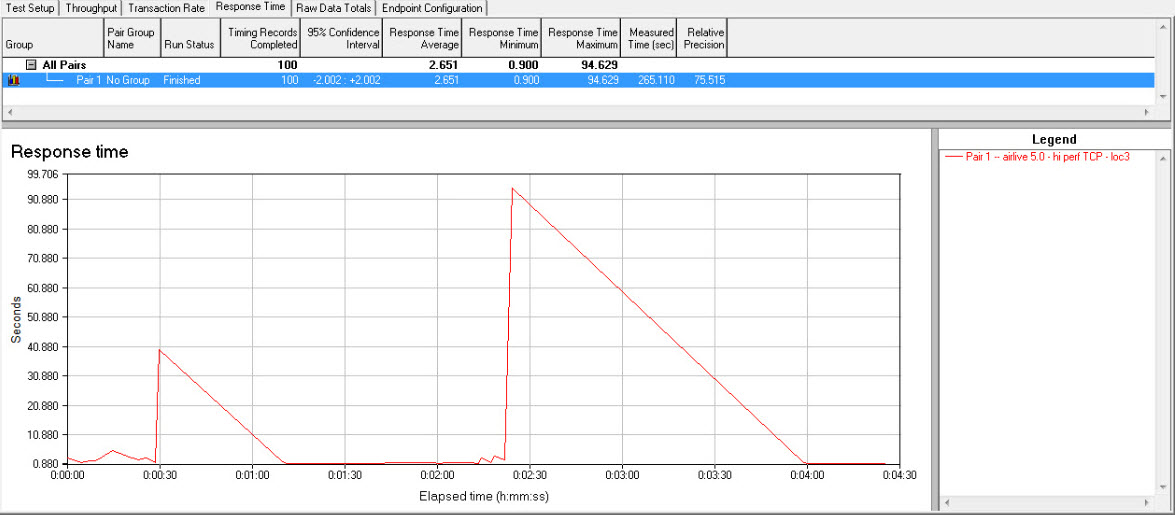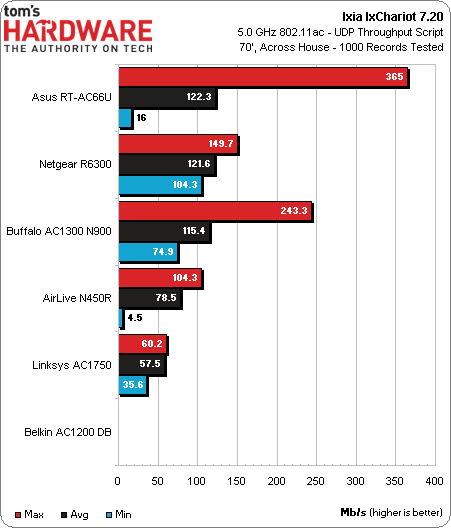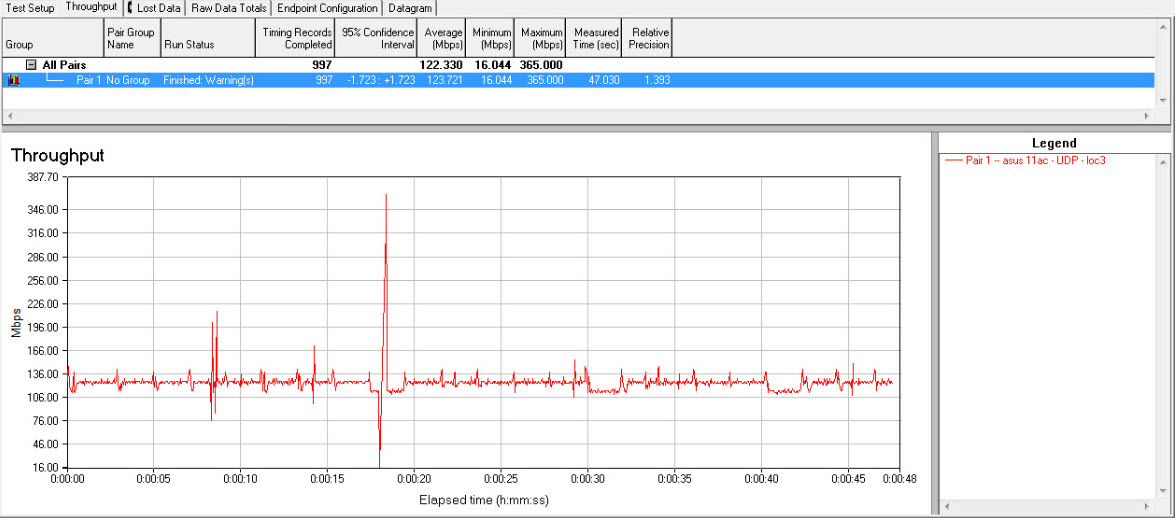Gigabit Wireless? Five 802.11ac Routers, Benchmarked
Five years ago, we didn't have homes with a dozen wireless nodes and the need to run HD video to multiple screens. Today we do. Our 802.11n networks, especially on the 2.4 GHz band, are swamped. Can 802.11ac save the day? We test six routers to find out.
Results: IxChariot
Why you can trust Tom's Hardware
Crossing over to 2.4 GHz 802.11n in the same-room tests, we have more weirdness. For once, Belkin does not have the lowest number on the chart. Whereas AirLive, Asus, and Buffalo are do a respectable job of not letting throughput drop under 50 Mb/s, Linksys and Netgear both have instances where they bottom out at 5 Mb/s. Even Belkin manages a fractional improvement over that. Sure, Belkin has the worst average, but we’re looking under every rock for good news at this point. Because we’re working with 802.11n, we should be dealing with a level playing field stocked with vendors handling a fully mature and refined technology. So it’s interesting to see AirLive edge past a respected name like Buffalo and fully trounce Linksys and Netgear. Only Asus manages to keep the small upstart in second place (by a gaping margin).
With our UDP chart, we see the throughput numbers shift relative to TCP. AirLive and Asus nudge down a bit while Buffalo, Linksys, and Netgear all edge up. Since Linksys stands out as the chart’s highest outlier, let’s take a look at that.
Pretty telling, right? The top spike on this chart is almost five times higher than the clearly visible average line. Just as disturbing are the many dips into the sub-20 Mb/s range. Keep in mind that this is a same-room test. We are left acknowledging that there is a fair amount of ambient noise and unpredictability in our test environment, but, at the same time, it’s a fairly average suburban scenario, and this is what routers need to cope with in the real world. We find the fact that Linksys and Netgear struggle here disturbing.
Now for the cross-house 11ac test with TCP traffic. Again, we see Belkin failing to connect, and AirLive finally manages to walk off a cliff. In fact, here’s what life looks like at the bottom of that cliff:
The good news is that AirLive managed to transmit all 100 IxChariot test records. The bad news is that most of those records came in two bursts, like flashbulbs in the dark, and the rest of the time saw almost no throughput. AirLive aside, we’re very impressed with the TCP results for our remaining competitors, although Linksys does noticeably lag behind the other three. With an average of roughly 180 Mb/s for Asus, Buffalo, and Netgear, this compares very well with the approximately 240 Mb/s averaged by those three in our similar close-distance test. A 25% throughput loss under such difficult conditions is actually phenomenal.
UDP across the house 11ac is definitely slower under 802.11ac, but still very usable and reliable in most cases. Netgear now turns in a stable performance with the best minimum throughput rate on the chart. Asus wins on the average number, but look at the deeper test chart:
For a long-distance test through flooring and walls, Asus’s stability here is outstanding. We only see one major blip, and we’re guessing that some random bit of ambient interference clobbered throughput for an instant, and the router responded by boosting power to compensate. When positive ambient conditions returned, the router dropped power back to normal levels. That’s a guess, but no matter what, this chart illustrates the Asus product’s ability to hold an 802.11ac signal with excellent stability and respond very quickly to adverse conditions.
Current page: Results: IxChariot
Prev Page Results: IxChariot, Same-Room, 5.0 GHz Next Page Results: IxChariot, Across-House, 2.4 GHzGet Tom's Hardware's best news and in-depth reviews, straight to your inbox.
-
boulbox Well, i can't wait until i can make my router give wifi all the way to my to my work area.(only a few blocks away)Reply -
I've tested both the R6300 and the RT-AC66U in my home. The R6300 beats it hands down. The average homes won't have the traffic that your artificial software creates. Even your tests show that R6300 in 5ghz mode is faster. People will buy these for gaming and HD movie viewing and the R6300 has better range as well. I've paired my R6300 with an ASUS PCE-AC66 desktop wireless AC adapter and I can acheive 30 MB/S (megabytes) to my HTPC in a 2 story house. That's an insane speed. The RT-AC66U only managed about 15 to 18 MB/s. Also make sure the R6300 has the latest firmware, which is V1.0.2.38_1.0.33. But in conclusion, the R6300 and the RT-AC66U are like a SRT Viper and ZR1 Vette. They are both great pieces of hardware to fit most users needs. Get the ASUS If you got a ton of traffic and a lot of 2.4 ghz devices. Grab the R6300 if you are looking for a friendly setup, max speed, and max range.Reply
-
fwupow Man it sure sucks when you type a long comment and it gets vaporized cuz you weren't logged in.Reply -
DeusAres I'd be happy with a 2Mb/s connection. It'd be better than this horrible 512 Kb/s connection I have now. At least then, I may actually be able to watch youtube vids in 360p.Reply -
fwupow Here's the gist of what I typed before it was rudely vaporized.Reply
I have a dual-band router (Netgear N600). I also purchased a couple of dual-band client USB adapters Linksys AE2500 or something to that effect.
So the USB adapter works fine for a desktop, but having that crap sticking out the side of a laptop, netbook or tablet? Busted in 10 minutes. I hooked one up to my netbook and fried it within a couple of weeks because I'm a Netbook in bed guy. You wouldn't think it could get so hot from a USB port but it does.
So the reality is that you have all these devices that can't be upgraded to dual-band and enjoy very little if any benefit from the new-fangled dual-band router.
The other beef I have with routers is that they're terrible with the way they split up bandwidth between multiple devices. Instead of responsively reassigning bandwidth to the device that needs it, the router continues to reserve a major slice for a device that I'm not using.
If you live in an apartment building, it's actually rather rude to use the full 300Mbps capacity of the wireless N band, since you may well succeed in effectively shutting your neighbor down. There's so much happening in the 2.4GHz band nowadays, it's unreal. Your own cordless keyboards/mice/controllers etc can malfunction from being unable to get a packet in edgewise.
For these dual-band routers to be really useful, we need manufacturers of smartphones, tablets, laptops, netbook and such to build dual-band clients into them because adding the functionality with some sort of dongle just doesn't work. -
memadmax I was a 802.11g and n "adoption" tester....Reply
Never again...
I'll give ac a year or two before I jump on it... -
SteelCity1981 my wireless N produces 300 Megabits which would equal around 37 Megabytes. My highspeed internet doesn't come cloe to reaching 37 megabytes and i don't transfer tons of files wirelesly and my wi-fi rangs is pretty good .So i'm perfectly fine with my 300MB N wireless router right now. Besides that none of my devices spport ac anyhow so it would get bottlenecked from reaching its full potential.Reply -
chuckchurch iknowhowtofixit"Folks, the time to start your 802.11ac adoption is now."I think this review proved that it is time to wait for 2nd generation wireless AC routers to appear before rushing to purchase.Reply
Exactly. The 'client' adapter they used if anyone didn't catch it was a Cisco/Linksys router-sized device. Not practical by any means. It'd be totally insane to make any product recommendations prior to real client adapters being available, or more accurately, embedded ones are available. I think a wireless salesman wrote this article.
